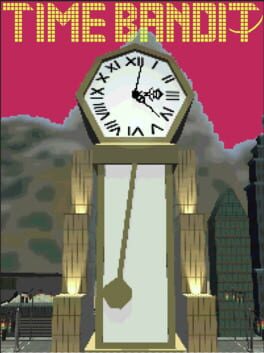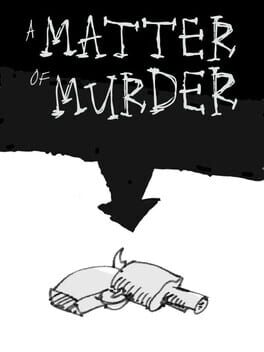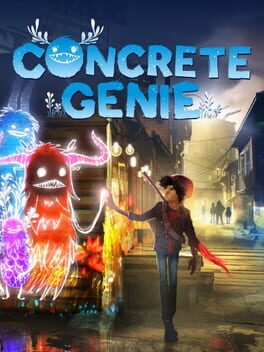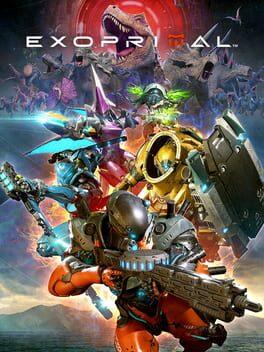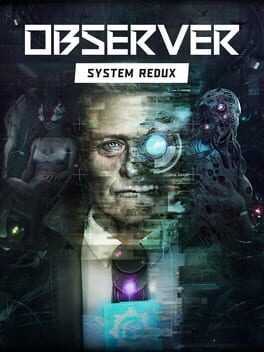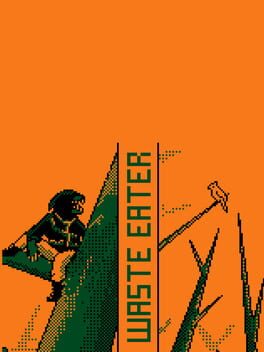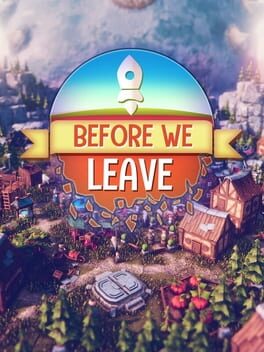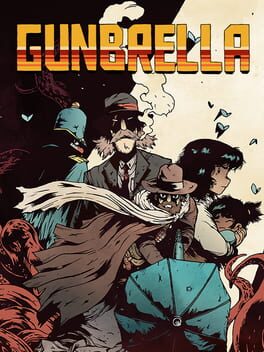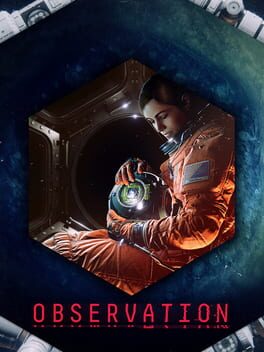TidB
132 Reviews liked by TidB
Time Bandit: Part 1 - Appendages of the Machine: Some neat concepts in a game purposefully designed to waste your time as much as possible (“All games are a waste of time,” fine, but not like this). Even if you agree with the heavy-handed political messages, you're sure to find them overbearing and obnoxious, especially when it's all padding around waiting, waiting, and more waiting.
You know how in Ocarina of Time, King Zora took forever to scoot out of the way so you could get behind him? Imagine if that was an entire video game. That's Time Bandit.
Literally the first thing the game does is waste your time. You watch a woman ride in an elevator which stops to pick up slow-moving, crystalline business people and stops again to let them off, one of them tarrying for no reason. When the woman gets to the top floor, the screen flips to a clock to show you time passing by, before she walks to her desk to boot up a slow-loading Windows 95. Then there's a brief and well-done tutorial of her flipping through a couple of games before you're launched into (I believe they're unnamed, so:) Company's orientation process.
You learn you're supposed to push boxes to get to crystals, the puzzle portion of this game. Each box takes half an hour of real time to move one space. If it's a trash pile which can't be pushed? Compacting it also takes half an hour before you can push it, which is still thirty minutes. “That's the point, it's wasting your time intentionally!” Okay, and? Why does that make it good? It's still successfully wasting your time if these actions only took ten minutes, just less excessively. Or is it better if it takes longer? Why not take an hour per action?
Your character only has something like thirty minutes (less, when active) of energy at a time. To fill it all the way back up, they need eight hours of real time rest. Hardy har har.
Again, the game is very political. I'm not a Communist because I live in the real world, yet there's no denying the power of collective bargaining and I'm fully aware that corporations LOVE to recklessly exploit anything and everything when given the opportunity. So despite me agreeing with portions of the rhetoric, I still found the conversations about it all to be dull and too lengthy. You're jumping into this game, a game clearly meant to be played for like fifteen minutes at a time, and in the middle of your trip to the facility you're locked in a long codec call with someone lecturing you about the pitfalls of automation for the working class. At least when your boss calls you to be an asshole, it's brief (and usually funny).
As someone who recently started working again, I definitely think it's good to ask yourself about your time spent at work and what you're getting for it. This game, in a nutshell, wants you to ask yourself that exact question. The problem is: once you're on that road, one of the next logical questions is “Why am I wasting my free time playing a game that intentionally makes things a hassle?” Certainly not for the flashy, impressive cutscenes; this game is clearly done in the spirit of the original Metal Gear Solid (it has its own Solid Snake) and looks just as old.
Despite the low fidelity, I found many areas caused a bizarre frame rate drop. I once loaded the game where I had left it (in my apartment), only to have my character go to court for the crime of trespassing... which, admittedly, I had just been doing, but I wasn't caught. I also had a codec call start while I was being run over by a minecart, which kept the camera stationary while my character moved around, forcing me to quit and restart the game while in the facility and go to jail for it. Jail is a twelve hour wait, by the way.
Lots of bads, I'd say. The goods? I actually like the MGS visuals, there's a charm in the simplicity (but why is the performance so lousy?). I liked the puzzles, especially the minecart section (but everything takes way too long for no payoff and the ending is a “To be continued” screen). I liked the occasional humor (when it wasn't at my expense). Hidden crystals in town was a good idea.
Eventually, I followed the dev's own personal guide (on the Steam discussions) of how to beat the clock. Frankly, you'd be stupid not to. There's even an achievement for booting up the game ten years later, I think they want you messing with your computer's time settings. I was able to sell all my crystals to the union and find the hidden ones around the city on my own, so I think I did well and do not feel bad about “cheating”.
I think it's wild that a game this deliberately annoying would have the gall to ask you to be excited (and wait some more!) for Part 2. I'm happy I supported a creative dude who, judging by his contributions in the Steam discussions, seems to be really considerate. However, this game is simply not a good game; it's a chore structured like a second job and there's no reward for your efforts. I highly doubt any of its structure can be changed much for Part 2 without making Part 1 look even more laborious, so I am not looking forward to it. I think I've served my time.
I wish Joel Jordan the best of luck on whatever comes after Time Bandit is through.
I do not recommend Time Bandit.
You know how in Ocarina of Time, King Zora took forever to scoot out of the way so you could get behind him? Imagine if that was an entire video game. That's Time Bandit.
Literally the first thing the game does is waste your time. You watch a woman ride in an elevator which stops to pick up slow-moving, crystalline business people and stops again to let them off, one of them tarrying for no reason. When the woman gets to the top floor, the screen flips to a clock to show you time passing by, before she walks to her desk to boot up a slow-loading Windows 95. Then there's a brief and well-done tutorial of her flipping through a couple of games before you're launched into (I believe they're unnamed, so:) Company's orientation process.
You learn you're supposed to push boxes to get to crystals, the puzzle portion of this game. Each box takes half an hour of real time to move one space. If it's a trash pile which can't be pushed? Compacting it also takes half an hour before you can push it, which is still thirty minutes. “That's the point, it's wasting your time intentionally!” Okay, and? Why does that make it good? It's still successfully wasting your time if these actions only took ten minutes, just less excessively. Or is it better if it takes longer? Why not take an hour per action?
Your character only has something like thirty minutes (less, when active) of energy at a time. To fill it all the way back up, they need eight hours of real time rest. Hardy har har.
Again, the game is very political. I'm not a Communist because I live in the real world, yet there's no denying the power of collective bargaining and I'm fully aware that corporations LOVE to recklessly exploit anything and everything when given the opportunity. So despite me agreeing with portions of the rhetoric, I still found the conversations about it all to be dull and too lengthy. You're jumping into this game, a game clearly meant to be played for like fifteen minutes at a time, and in the middle of your trip to the facility you're locked in a long codec call with someone lecturing you about the pitfalls of automation for the working class. At least when your boss calls you to be an asshole, it's brief (and usually funny).
As someone who recently started working again, I definitely think it's good to ask yourself about your time spent at work and what you're getting for it. This game, in a nutshell, wants you to ask yourself that exact question. The problem is: once you're on that road, one of the next logical questions is “Why am I wasting my free time playing a game that intentionally makes things a hassle?” Certainly not for the flashy, impressive cutscenes; this game is clearly done in the spirit of the original Metal Gear Solid (it has its own Solid Snake) and looks just as old.
Despite the low fidelity, I found many areas caused a bizarre frame rate drop. I once loaded the game where I had left it (in my apartment), only to have my character go to court for the crime of trespassing... which, admittedly, I had just been doing, but I wasn't caught. I also had a codec call start while I was being run over by a minecart, which kept the camera stationary while my character moved around, forcing me to quit and restart the game while in the facility and go to jail for it. Jail is a twelve hour wait, by the way.
Lots of bads, I'd say. The goods? I actually like the MGS visuals, there's a charm in the simplicity (but why is the performance so lousy?). I liked the puzzles, especially the minecart section (but everything takes way too long for no payoff and the ending is a “To be continued” screen). I liked the occasional humor (when it wasn't at my expense). Hidden crystals in town was a good idea.
Eventually, I followed the dev's own personal guide (on the Steam discussions) of how to beat the clock. Frankly, you'd be stupid not to. There's even an achievement for booting up the game ten years later, I think they want you messing with your computer's time settings. I was able to sell all my crystals to the union and find the hidden ones around the city on my own, so I think I did well and do not feel bad about “cheating”.
I think it's wild that a game this deliberately annoying would have the gall to ask you to be excited (and wait some more!) for Part 2. I'm happy I supported a creative dude who, judging by his contributions in the Steam discussions, seems to be really considerate. However, this game is simply not a good game; it's a chore structured like a second job and there's no reward for your efforts. I highly doubt any of its structure can be changed much for Part 2 without making Part 1 look even more laborious, so I am not looking forward to it. I think I've served my time.
I wish Joel Jordan the best of luck on whatever comes after Time Bandit is through.
I do not recommend Time Bandit.
ETA: the developer is working on an upmake with real art that you can wishlist on steam now! i'm really glad.
https://jjohnstongames.itch.io/the-roottrees-are-dead/devlog/690887/the-roottrees-are-dead-but-for-real-this-time
6-10 hour family deduction and mystery. absolutely love this, especially as the work of one person almost totally alone. please don't pay for it, because the art is all AI generated -- that's a weird, bad choice the creator made and i don't understand why. the AI art is so bad that it does not ever add a sense of realism to anything, so it could really easily be simple line art or something similar. hell, he could have used visual novel sprites. if there's ever a release with real photographs or real art -- wait and pay for that.
https://jjohnstongames.itch.io/the-roottrees-are-dead/devlog/690887/the-roottrees-are-dead-but-for-real-this-time
6-10 hour family deduction and mystery. absolutely love this, especially as the work of one person almost totally alone. please don't pay for it, because the art is all AI generated -- that's a weird, bad choice the creator made and i don't understand why. the AI art is so bad that it does not ever add a sense of realism to anything, so it could really easily be simple line art or something similar. hell, he could have used visual novel sprites. if there's ever a release with real photographs or real art -- wait and pay for that.
A Matter of Murder
2016
It is a shame that usually videogames don't stand such deep and mature stories. Yeah, I understand the game based on book (very good one) but is it really a problem to have more games based on books?
After The Pillars of the Earth it is really hard to even look on moviesque games. They just so lose in comparison. I can't believe anyone can say the story in Heavy Rain is better than in this one.
As I know, developers met some problems at half way so 3rd book plays in rush. I wanted more detailed scenes here and there, some moments were so emotional, but every chapter takes around 10 minutes, characters jump from one period of time to another in a moment, from one location to another.
I will definitely read a book to deal with my feeling of "unbacked" story. Regardless of that, the visual and atmosphere is stunning. I wish developers will convert it into full meter movie one day.
After The Pillars of the Earth it is really hard to even look on moviesque games. They just so lose in comparison. I can't believe anyone can say the story in Heavy Rain is better than in this one.
As I know, developers met some problems at half way so 3rd book plays in rush. I wanted more detailed scenes here and there, some moments were so emotional, but every chapter takes around 10 minutes, characters jump from one period of time to another in a moment, from one location to another.
I will definitely read a book to deal with my feeling of "unbacked" story. Regardless of that, the visual and atmosphere is stunning. I wish developers will convert it into full meter movie one day.
Concrete Genie
2019
Exoprimal
2023
Nur kurz am Free Weekend gespielt.
Was ich so faszinierend an Exoprimal finde, ist, wie das größte Problem des Spiels so offensichtlich ist.
Ich hatte bei Release nur ein paar Sachen zu diesem Spiel gesehen, alles was ich noch im Kopf hatte war ein "Mechaniken gut, Spielstruktur schlecht", ohne spezifisch zu wissen was nun genau so schlecht daran sein sollte.
Und ja, die Mechaniken... sind nett. Die Präsentation ist ganz cool. Und alles was es nun sein müsste, ist ein EDF in weniger janky.
Aber stattdessen hat es diesen komischen Zwang jede Runde zu einem Wettbewerb zwischen zwei Teams zu machen. Der einzige Unterschied zwischen PvE und PvP ist nur, ob man gegen Ende der Runde auf das andere Team trifft, oder nicht. Ein Wettbewerb bleibt es trotzdem.
Heißt, sobald du in der letzten Phase ankommst und die Mission schaffst, kommt trotzdem eine Animation wie du von Raptoren zerfleischt wirst, weil das andere unsichtbare Team marginal schneller war.
Als ein Kumpel (hi, Fynn) das Tutorial spielte, meinte er dass das richtig cool wirkt. Als wir die erste Mission abgeschlossen haben, kam ein "...und das wars?". Als wir die zweite Mission spielten, waren wir uns sicher "oh... das war echt schon alles".
Es gibt sicher mehr als genug Kritik an diesem Punkt, aber ich muss trotzdem erwähnen wie sehr das alles untergräbt. In Coopspielen gibt es sonst immer so viele Möglichkeiten Spaß zu haben. Du kannst die Gegend erforschen, du kannst rumalbern, du kannst silly Waffen ausprobieren, du kannst dich mit Freunden unterhalten, oder versuchen möglichst effizient zu arbeiten. Es gibt soooo viele Möglichkeiten ein Coopspiel zu genießen. Exoprimal hat einen eigenen Button nur für Emotes - glaub allerdings nicht, dass du den jemals benutzen wirst, wenn alles ein Rennen um die Zeit ist. Alles was nicht hyper-fokussiertes, effizientes spielen ist, ist verschwendete Zeit und vielleicht eine verlorene Runde. Du kannst es nicht wagen auch nur für einen Moment die Ruhe zu genießen. Willkommen bei Awesome Games Done Quick, hier geht um alles.
Was mich aber so fasziniert, ist, wie schnell das einem ins Gesicht springt. Ich glaub, das ist von fast jedem der größte Kritikpunkt am Spiel. Soweit ich weiß, mögen nur recht wenige Leute /diesen/ Schwerpunkt des Spiels.
Aber das ist kein Problem auf was man erst nach 10 Stunden stößt, das ist nichts was erst ein Pro Player nach 400 Spielstunden langsam discovered hat, das wird dir direkt ins Gesicht gerieben. Jahre an Entwicklungskosten, reingesteckt in ein Konzept das es wirklich nicht wert war zu entwickeln.
Was ich so faszinierend an Exoprimal finde, ist, wie das größte Problem des Spiels so offensichtlich ist.
Ich hatte bei Release nur ein paar Sachen zu diesem Spiel gesehen, alles was ich noch im Kopf hatte war ein "Mechaniken gut, Spielstruktur schlecht", ohne spezifisch zu wissen was nun genau so schlecht daran sein sollte.
Und ja, die Mechaniken... sind nett. Die Präsentation ist ganz cool. Und alles was es nun sein müsste, ist ein EDF in weniger janky.
Aber stattdessen hat es diesen komischen Zwang jede Runde zu einem Wettbewerb zwischen zwei Teams zu machen. Der einzige Unterschied zwischen PvE und PvP ist nur, ob man gegen Ende der Runde auf das andere Team trifft, oder nicht. Ein Wettbewerb bleibt es trotzdem.
Heißt, sobald du in der letzten Phase ankommst und die Mission schaffst, kommt trotzdem eine Animation wie du von Raptoren zerfleischt wirst, weil das andere unsichtbare Team marginal schneller war.
Als ein Kumpel (hi, Fynn) das Tutorial spielte, meinte er dass das richtig cool wirkt. Als wir die erste Mission abgeschlossen haben, kam ein "...und das wars?". Als wir die zweite Mission spielten, waren wir uns sicher "oh... das war echt schon alles".
Es gibt sicher mehr als genug Kritik an diesem Punkt, aber ich muss trotzdem erwähnen wie sehr das alles untergräbt. In Coopspielen gibt es sonst immer so viele Möglichkeiten Spaß zu haben. Du kannst die Gegend erforschen, du kannst rumalbern, du kannst silly Waffen ausprobieren, du kannst dich mit Freunden unterhalten, oder versuchen möglichst effizient zu arbeiten. Es gibt soooo viele Möglichkeiten ein Coopspiel zu genießen. Exoprimal hat einen eigenen Button nur für Emotes - glaub allerdings nicht, dass du den jemals benutzen wirst, wenn alles ein Rennen um die Zeit ist. Alles was nicht hyper-fokussiertes, effizientes spielen ist, ist verschwendete Zeit und vielleicht eine verlorene Runde. Du kannst es nicht wagen auch nur für einen Moment die Ruhe zu genießen. Willkommen bei Awesome Games Done Quick, hier geht um alles.
Was mich aber so fasziniert, ist, wie schnell das einem ins Gesicht springt. Ich glaub, das ist von fast jedem der größte Kritikpunkt am Spiel. Soweit ich weiß, mögen nur recht wenige Leute /diesen/ Schwerpunkt des Spiels.
Aber das ist kein Problem auf was man erst nach 10 Stunden stößt, das ist nichts was erst ein Pro Player nach 400 Spielstunden langsam discovered hat, das wird dir direkt ins Gesicht gerieben. Jahre an Entwicklungskosten, reingesteckt in ein Konzept das es wirklich nicht wert war zu entwickeln.
Alan Wake II
2023
It's been 13 years since the cliff-hanger ending of Alan Wake and AW2 was well worth the wait. It's the result of 13 years of lessons learned, refining the formula, and Remedy perfecting their craft to produce a thrilling, innovative, and mind bending story that had me glued from start to finish.
The game cycles between 2 main stories, FBI agents Saga Anderson and Alex Casey investigating a cult at Bright Falls and Alan Wake trying to escape the dark place. Both stories have 10 chapters and you can play them alternating or one then the other. Both stories are intertwined and give one another context but it's difficult to get into more detail without spoilers, needless to say the story threads are beautifully woven into a lattice of narrative that ties everything together, fills in past blanks, and leaves a few interesting loose threads to explore in the future.
AW2 has, hands down, one of the most intricate and well crafted plots I've seen, juggling the meta-narrative with post-modern deconstruction of stories within stories in ways that I could gush about embarrassingly for hours. Granted it can get complicated in places but if you're the kind of person who enjoys a deep, tangled, paranormal thriller then you're in for a treat. If you found the first game too narrative heavy then your mileage may vary as this one follows a deeply cinematic streak with a hefty portion of in-world media to soak in. Similar to AW1 you have a novel's worth of writing to read, radio shows, music, and TV-skits recorded with the real actors who play the cast of characters in the game akin to Control. If you enjoyed that rich world building you're in for a treat!
As for gameplay, it's a fusion of classic Silent Hill and modern Resident Evil bringing the best of both worlds along with Remedy's original recipe, plus they've learned well from their past mistakes. We see a return of the light mechanics, burning off the darkness and then shooting enemies, and while yes the combat is still simple, repetitive, and enemies only have a small variety, combat is kept interesting with a variety of toys/weapons to use, and then broken up by the huge variety of other things to do. Puzzles, exploration, collectibles, conversations, and the stand-out Writers Room / Mind Place mechanics. So when you do have combat it's not around long and doesn't overstay it's welcome like in past games.
The writers room and mind place are new features which each gamify the narrative in different ways giving Saga and Wake's gameplay entirely different feels. Saga has 'the mind place' which is a room in her mind represented as a physical space you walk around, where you can review collectibles, manage upgrades, and track the many twisting narrative threads on an evidence board, pinning up plot points, characters, and evidence as you investigate the mystery, tied together with string and punctuated with Saga's thoughts and conclusions as you go. It makes for a fun way to keep track of everything and identify where to go or what to do next in the 3 major locations around Bright Falls.
Meanwhile Wake has 'the writers room', where he's trapped in the darkness and trying to write his way out. The physical space of the darkness transforms based on his writing, so in each chapter he superimposes a thriller story over his imagined reality and you use the plot points to physically transform the space. A hotel ballroom can host a cult meeting or a ritual murder scene - each with different clues to discover and different paths blocked off. This fractal narrative-within-narrative-within-narrative structure is inspiring to see implemented so naturally and turns the world itself into a unique and interesting puzzle to solve.
AW2 is a refreshing creative vision that is badly needed these days. It captures the atmosphere of horror beautifully and marries media in such creative ways while telling a story in ways no other medium can - this is what video games were made for. On top of that it combines an outstanding story, amazing writing and cinematography, innovative gameplay, a vast supply of world enriching collectibles, stirring performances from the actors, incredible music, a return of everything iconic that Remedy fans loved from the past games, the best graphics I've ever seen, exciting new twists, turns, characters, and developments... what does the game get wrong? Honestly just a handful of glitches, a couple of lip syncing issues, and having to select the only item that works with an interactable from a list.
At the very least it's fair to say that Remedy gets so much right here that its few flaws are easily overlooked. Given the sheer quality of Remedy's content and the hard work on display Alan Wake 2 is definitely my pick for game of the year, and with even more content on the way I can't wait to see what's next. It's amazing to see a company do AAA games justice now more than ever, producing genuine works of art rather than revenue engines. The spirit of true game design is alive in Remedy and I'm proud to support them.
Onnea ja hyvin tehty!
The game cycles between 2 main stories, FBI agents Saga Anderson and Alex Casey investigating a cult at Bright Falls and Alan Wake trying to escape the dark place. Both stories have 10 chapters and you can play them alternating or one then the other. Both stories are intertwined and give one another context but it's difficult to get into more detail without spoilers, needless to say the story threads are beautifully woven into a lattice of narrative that ties everything together, fills in past blanks, and leaves a few interesting loose threads to explore in the future.
AW2 has, hands down, one of the most intricate and well crafted plots I've seen, juggling the meta-narrative with post-modern deconstruction of stories within stories in ways that I could gush about embarrassingly for hours. Granted it can get complicated in places but if you're the kind of person who enjoys a deep, tangled, paranormal thriller then you're in for a treat. If you found the first game too narrative heavy then your mileage may vary as this one follows a deeply cinematic streak with a hefty portion of in-world media to soak in. Similar to AW1 you have a novel's worth of writing to read, radio shows, music, and TV-skits recorded with the real actors who play the cast of characters in the game akin to Control. If you enjoyed that rich world building you're in for a treat!
As for gameplay, it's a fusion of classic Silent Hill and modern Resident Evil bringing the best of both worlds along with Remedy's original recipe, plus they've learned well from their past mistakes. We see a return of the light mechanics, burning off the darkness and then shooting enemies, and while yes the combat is still simple, repetitive, and enemies only have a small variety, combat is kept interesting with a variety of toys/weapons to use, and then broken up by the huge variety of other things to do. Puzzles, exploration, collectibles, conversations, and the stand-out Writers Room / Mind Place mechanics. So when you do have combat it's not around long and doesn't overstay it's welcome like in past games.
The writers room and mind place are new features which each gamify the narrative in different ways giving Saga and Wake's gameplay entirely different feels. Saga has 'the mind place' which is a room in her mind represented as a physical space you walk around, where you can review collectibles, manage upgrades, and track the many twisting narrative threads on an evidence board, pinning up plot points, characters, and evidence as you investigate the mystery, tied together with string and punctuated with Saga's thoughts and conclusions as you go. It makes for a fun way to keep track of everything and identify where to go or what to do next in the 3 major locations around Bright Falls.
Meanwhile Wake has 'the writers room', where he's trapped in the darkness and trying to write his way out. The physical space of the darkness transforms based on his writing, so in each chapter he superimposes a thriller story over his imagined reality and you use the plot points to physically transform the space. A hotel ballroom can host a cult meeting or a ritual murder scene - each with different clues to discover and different paths blocked off. This fractal narrative-within-narrative-within-narrative structure is inspiring to see implemented so naturally and turns the world itself into a unique and interesting puzzle to solve.
AW2 is a refreshing creative vision that is badly needed these days. It captures the atmosphere of horror beautifully and marries media in such creative ways while telling a story in ways no other medium can - this is what video games were made for. On top of that it combines an outstanding story, amazing writing and cinematography, innovative gameplay, a vast supply of world enriching collectibles, stirring performances from the actors, incredible music, a return of everything iconic that Remedy fans loved from the past games, the best graphics I've ever seen, exciting new twists, turns, characters, and developments... what does the game get wrong? Honestly just a handful of glitches, a couple of lip syncing issues, and having to select the only item that works with an interactable from a list.
At the very least it's fair to say that Remedy gets so much right here that its few flaws are easily overlooked. Given the sheer quality of Remedy's content and the hard work on display Alan Wake 2 is definitely my pick for game of the year, and with even more content on the way I can't wait to see what's next. It's amazing to see a company do AAA games justice now more than ever, producing genuine works of art rather than revenue engines. The spirit of true game design is alive in Remedy and I'm proud to support them.
Onnea ja hyvin tehty!
It's a short hidden object game with cats. My gameplay consisted mostly of clicking on everything that looked even remotely clickable, bc I decided to go full-on petting every cat in the vicinity. Money and time well spent.
P.S. The devs added the bunker floor after I finished the game. Not a fan of these kind of decisions since they're easy to miss.
P.S. The devs added the bunker floor after I finished the game. Not a fan of these kind of decisions since they're easy to miss.
A pretty good sci-fi horror experience. It's got tons of body and existential horror, with some genuinely disturbing imagery and ideas at play, and some actually terrifying sequences - mostly due to excellent sound design. I really enjoyed the investigative elements in the beginning and then the slow descent into madness that occurs over the course of the game.
The only downside is the forced stealth sections, which reminded me quite unfondly of the demon sequences from Murdered: Soul Suspect (for the five people who actually played and remember that game). I get that there has to be some kind of stakes, but those sections just felt very lazy and tacked on. Even the monster's visual cone is a lie as sometimes they spot you poking 1cm out of a corner and other times they can walk right past you without a care in the world.
Overall though, I had a good experience with this. It's a blend of different cyberpunk stories and ideas, but it was well executed. We got some Bladerunner, we got some Cyberpunk, it was a nice grab bag of references and technologies. I haven't played Layers of Fear, just because it looked like a pretty generic PT-inspired horror experience, but after going through this game, I might just have to check those out as well.
The only downside is the forced stealth sections, which reminded me quite unfondly of the demon sequences from Murdered: Soul Suspect (for the five people who actually played and remember that game). I get that there has to be some kind of stakes, but those sections just felt very lazy and tacked on. Even the monster's visual cone is a lie as sometimes they spot you poking 1cm out of a corner and other times they can walk right past you without a care in the world.
Overall though, I had a good experience with this. It's a blend of different cyberpunk stories and ideas, but it was well executed. We got some Bladerunner, we got some Cyberpunk, it was a nice grab bag of references and technologies. I haven't played Layers of Fear, just because it looked like a pretty generic PT-inspired horror experience, but after going through this game, I might just have to check those out as well.
Waste Eater
2023
Before We Leave
2020
There's definitely a solid core of crunchy city-building within this game. The core logic of a hex-based map with various adjacency bonuses is smart, giving rise to a lot of emergent strategy out of a relatively understandable set of mechanics. But it fumbles many of the details that are necessary to grow that idea into a complete game, and ends up a frustrating shadow of what it could have been.
While my wife and I played this game together, we came up with a laundry list of complaints about it ranging from the control scheme (Why is there no hotkey for switching between planets?) to the UI decisions (Adjusting storage in a warehouse is a nightmare) to the onboarding (Why is there no Civilopedia equivalent? Why doesn't it explain core concepts like "an action"?). But ultimately, our biggest issues fell into two categories: transparency and suburbism.
The first is especially egregious in comparison to The Colonists, which is an excellent city-builder largely because it gives the player so much visibility into and control over the details of how resources flow through your civ. This is crucial for games like this, because it provides another avenue of emergent strategy, but it's totally absent in Before We Leave where you can see resources in motion, but you can't easily track them at rest or understand how their flow operates over time. It's hard to understand the paths your peeps travel even though the adjacency mechanics make this pathing critical to the player's success.
Specifically, passing near certain tiles (fountains, trees) improves the mood of a given peep while passing near others (tall buildings, pollution) makes them unhappy. Because housing imposes substantial tall building "gloom" penalties and the best food production produces pollution, you're incentivized to reproduce a suburban city layout with home, work, and food separated strictly by function. While this could pose an interesting mechanical puzzle, as a human player I want to build a city I'd like to live in. I personally love walking among mixed-use apartments, row houses, and restaurants and it's a bummer to play a game that frames that as bad.
Even the mechanical puzzle kind of sucks, though. The gloom mechanic discourages density of housing, but housing adjacency bonuses are so strong as to outweigh that completely—meaning that you just have an ambient gloom penalty all the time that you can't really address. As the game moves to later stages, this seems to be its constant theme: it keeps asking you to cram more and more things into the same number of tiles without giving you tools to improve efficiency or positive motivation to rethink layouts. (There is one notable counterexample, the step warehouse, which is worth highlighting because I wish the game had more improvements like that.)
This was a fun few hours of initial exploration, but the substantial amount of lategame content (including fighting off hostile NPCs which we haven't even talked about) just felt like a slog. And just to add insult to injury, the unlockable "reward" tiles like the Park and the Pond simply do nothing at all! What is the point.
While my wife and I played this game together, we came up with a laundry list of complaints about it ranging from the control scheme (Why is there no hotkey for switching between planets?) to the UI decisions (Adjusting storage in a warehouse is a nightmare) to the onboarding (Why is there no Civilopedia equivalent? Why doesn't it explain core concepts like "an action"?). But ultimately, our biggest issues fell into two categories: transparency and suburbism.
The first is especially egregious in comparison to The Colonists, which is an excellent city-builder largely because it gives the player so much visibility into and control over the details of how resources flow through your civ. This is crucial for games like this, because it provides another avenue of emergent strategy, but it's totally absent in Before We Leave where you can see resources in motion, but you can't easily track them at rest or understand how their flow operates over time. It's hard to understand the paths your peeps travel even though the adjacency mechanics make this pathing critical to the player's success.
Specifically, passing near certain tiles (fountains, trees) improves the mood of a given peep while passing near others (tall buildings, pollution) makes them unhappy. Because housing imposes substantial tall building "gloom" penalties and the best food production produces pollution, you're incentivized to reproduce a suburban city layout with home, work, and food separated strictly by function. While this could pose an interesting mechanical puzzle, as a human player I want to build a city I'd like to live in. I personally love walking among mixed-use apartments, row houses, and restaurants and it's a bummer to play a game that frames that as bad.
Even the mechanical puzzle kind of sucks, though. The gloom mechanic discourages density of housing, but housing adjacency bonuses are so strong as to outweigh that completely—meaning that you just have an ambient gloom penalty all the time that you can't really address. As the game moves to later stages, this seems to be its constant theme: it keeps asking you to cram more and more things into the same number of tiles without giving you tools to improve efficiency or positive motivation to rethink layouts. (There is one notable counterexample, the step warehouse, which is worth highlighting because I wish the game had more improvements like that.)
This was a fun few hours of initial exploration, but the substantial amount of lategame content (including fighting off hostile NPCs which we haven't even talked about) just felt like a slog. And just to add insult to injury, the unlockable "reward" tiles like the Park and the Pond simply do nothing at all! What is the point.
Gunbrella
2023
A pretty fun little experience. I am usually very bad at these types of games, but this one was a blast to play through and the platforming never reached a level that was just frustratingly difficult to complete. The story and characters are great and endearing and the ending was a nicely satisfying little cap-off to the whole adventure.
Observation
2019
A decent enough horror experience. A sort of "spiritual successor" to Dead Space, you can really see some of the DNA from that franchise here, but unfortunately just not executed as well.
The story is pretty boilerplate, with bland characters and cliche plot threads. In the year of our Lord 2023, I didn't think we'd ever get another boring, shaved-head, gruff-voiced main character, plucked straight from 2008.
The combat is heavily melee-focused and meaty, but it does get old and repetitive quickly as there are about 5 or 6 enemy types in the entire game - most of which you don't even encounter that often.
The scares are also lacklustre and unimpactful, which is something you DON'T want in a horror game. There was never a single moment that gave me actual dread or made my heart race.
Overall though, I didn't hate the game by any means. It's just very lacklustre and I was kinda hoping for something more the entire time I was going through it. Thankfully, it's not too long, although it can feel padded out at times. It also looks very good, even on PS4, with some nice, claustrophobic area design.
The story is pretty boilerplate, with bland characters and cliche plot threads. In the year of our Lord 2023, I didn't think we'd ever get another boring, shaved-head, gruff-voiced main character, plucked straight from 2008.
The combat is heavily melee-focused and meaty, but it does get old and repetitive quickly as there are about 5 or 6 enemy types in the entire game - most of which you don't even encounter that often.
The scares are also lacklustre and unimpactful, which is something you DON'T want in a horror game. There was never a single moment that gave me actual dread or made my heart race.
Overall though, I didn't hate the game by any means. It's just very lacklustre and I was kinda hoping for something more the entire time I was going through it. Thankfully, it's not too long, although it can feel padded out at times. It also looks very good, even on PS4, with some nice, claustrophobic area design.
Starfield
2023
I think the best way to sum up Bethesda's effort with Starfield (other than just calling it “Fallout 4 in space”, which it is, but that's far from original at this point and I need to ramble) is to just look at the Red Mile quest.
In a space bar that's too dim yet hurts your eyes no matter where you look, a woman named Mei promises you certain death in “The Red Mile”; some challenge you won't remotely begin to fear because even at a measly level 12, you're slaughtering anything stupid enough to fight you. You follow her to the hype platform (which looks like the galaxy's cheapest VIP section), each step taking you closer to the annoying, looping music's source. It gets louder and louder and when Mei finally speaks into the microphone, she's almost fully drowned out by the shitty tune.
The gathering to see you off on this edge of your seat adventure is... four NPCs. When Mei is done riling up this “crowd” - who could fit in a Mini Cooper - three of them clap soundlessly. You can't even bet on yourself because that's just obviously free money. One patron goes to longingly gaze out the window, but it only reflects the room's interior. The reflection is missing almost all of the assets that should be there, including you and the would-be gazer himself. He doesn't seem to care.
The Red Mile itself is infested with the worst bulletsponge enemies you've seen yet and they'll concuss you with insta-explosion, toxic shit-bombs. They'll give a tease of experience per ammo-wasting kill. And you can get stunned really easily now! That was a smart choice for combat flow.
When I completed the “impossible” task of flipping a switch then running away from this horrid mess, Mei met with me in the world of blistering snow and no atmosphere to congratulate me while she wore no spacesuit. None of this surprises me, but people thinking highly of this absolutely blows my mind. The “I built a computer/bought a Series X for Starfield!” crowd almost disgusts me. Maybe Todd Howard is right, though, and all of this is my fault for not having a 4090 because I'm a dirt-coated peasant.
Bethesda knows how to make a video game, and you know this because they've made that same video game like four times now, and yet people still seem to clamor for more of the stale, sloppy mess. If this was your first ever Bethesda game, I could see someone enjoying this played out, buggy ride. I have friends who fall into this category, they'll get many hours out of Starfield. If you're familiar with Bethesda's work, though, you may say Starfield feels like one step forward and several steps back.
Is Starfield a bad game? Kind of, but I've played much worse. I wish I hadn't ever played Fallout 4 and had played this instead, but I can't go back and undo the hours which lead to the feeling of repetition. It is, beyond a doubt, comically sterile. “Space” doesn't really feel like space when it's just broken up into rooms, same as the Capital Wasteland or Skyrim. Whiterun was just a room and so is Mars, it's just a slightly nicer looking one. The trade for this visual upgrade is traveling anywhere is a bigger pain than ever before. “Space” is just a series of loading screens and animations you'll get sick of seeing immediately (thank god for mods).
The fact that you can see out of your ship's window is impressive to me, considering what they're working with. Just like I was “impressed” by Fallout 4 having real-time elevators (no longer in Starfield, and actually a good call as this saves you time). Modders, of course, swooped in immediately to fix stuff Bethesda should have already dealt with. How low is the bar for the multi-billion dollar company? The Ryujin "stealth" missions feel a college student's experiment, not "one of the most important RPGs ever made." (Xbox made this claim, not me.)
The best thing about Starfield is the return of the Adoring Fan. I cannot believe I just said that, but he rules and I'll stand by that forever. He has gifted me a plushie and a coffee mug and they're perfect. His voice actor still has it 100% down, each line brings me back to the fever-dream theater of Oblivion. If I can't have any innovation, I may as well at least get nostalgia. “My respect for you grows by the kilogram!” – This game's saving grace.
I do not recommend Starfield.
In a space bar that's too dim yet hurts your eyes no matter where you look, a woman named Mei promises you certain death in “The Red Mile”; some challenge you won't remotely begin to fear because even at a measly level 12, you're slaughtering anything stupid enough to fight you. You follow her to the hype platform (which looks like the galaxy's cheapest VIP section), each step taking you closer to the annoying, looping music's source. It gets louder and louder and when Mei finally speaks into the microphone, she's almost fully drowned out by the shitty tune.
The gathering to see you off on this edge of your seat adventure is... four NPCs. When Mei is done riling up this “crowd” - who could fit in a Mini Cooper - three of them clap soundlessly. You can't even bet on yourself because that's just obviously free money. One patron goes to longingly gaze out the window, but it only reflects the room's interior. The reflection is missing almost all of the assets that should be there, including you and the would-be gazer himself. He doesn't seem to care.
The Red Mile itself is infested with the worst bulletsponge enemies you've seen yet and they'll concuss you with insta-explosion, toxic shit-bombs. They'll give a tease of experience per ammo-wasting kill. And you can get stunned really easily now! That was a smart choice for combat flow.
When I completed the “impossible” task of flipping a switch then running away from this horrid mess, Mei met with me in the world of blistering snow and no atmosphere to congratulate me while she wore no spacesuit. None of this surprises me, but people thinking highly of this absolutely blows my mind. The “I built a computer/bought a Series X for Starfield!” crowd almost disgusts me. Maybe Todd Howard is right, though, and all of this is my fault for not having a 4090 because I'm a dirt-coated peasant.
Bethesda knows how to make a video game, and you know this because they've made that same video game like four times now, and yet people still seem to clamor for more of the stale, sloppy mess. If this was your first ever Bethesda game, I could see someone enjoying this played out, buggy ride. I have friends who fall into this category, they'll get many hours out of Starfield. If you're familiar with Bethesda's work, though, you may say Starfield feels like one step forward and several steps back.
Is Starfield a bad game? Kind of, but I've played much worse. I wish I hadn't ever played Fallout 4 and had played this instead, but I can't go back and undo the hours which lead to the feeling of repetition. It is, beyond a doubt, comically sterile. “Space” doesn't really feel like space when it's just broken up into rooms, same as the Capital Wasteland or Skyrim. Whiterun was just a room and so is Mars, it's just a slightly nicer looking one. The trade for this visual upgrade is traveling anywhere is a bigger pain than ever before. “Space” is just a series of loading screens and animations you'll get sick of seeing immediately (thank god for mods).
The fact that you can see out of your ship's window is impressive to me, considering what they're working with. Just like I was “impressed” by Fallout 4 having real-time elevators (no longer in Starfield, and actually a good call as this saves you time). Modders, of course, swooped in immediately to fix stuff Bethesda should have already dealt with. How low is the bar for the multi-billion dollar company? The Ryujin "stealth" missions feel a college student's experiment, not "one of the most important RPGs ever made." (Xbox made this claim, not me.)
The best thing about Starfield is the return of the Adoring Fan. I cannot believe I just said that, but he rules and I'll stand by that forever. He has gifted me a plushie and a coffee mug and they're perfect. His voice actor still has it 100% down, each line brings me back to the fever-dream theater of Oblivion. If I can't have any innovation, I may as well at least get nostalgia. “My respect for you grows by the kilogram!” – This game's saving grace.
I do not recommend Starfield.
